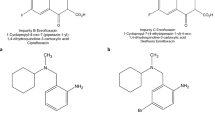Abstract
Capillary electrophoresis (CE) and it's applications in forensic toxicology are demonstrated by the investigation of amphetamine derivatives in “Ecstasy” tablets. The method is based on capillary zone electrophoresis (CZE) with a phosphate running buffer (pH 2.2). The drugs were dissolved in 0.01 N hydrochloric acid, diluted with distilled water and phenylephrine was added to the samples as an internal standard. A separation of the charged substances is obtained by the different velocities in the electric field. The qualitative determination can be made by the migration times or more accurately by the relative migration times. Other possibilities for identification are the UV-spectra using a diode array detector or the on-column standard addition procedure. By this procedure the sample solution is initially injected followed by the standard solution. Both are concentrated in the column before separation begins. CE shows clear advantages in comparison to high-performance liquid (HPLC) or gas chromatography (GC). The quantitative analysis was carried out using the internal standard phenylephrine.
The values obtained for 56 “Ecstasy” tablets and powder containing amphetamine or its derivatives were compared in this study after analysis with CE and HPLC. The results were in very good agreement. Because of it's speed, the high resolving power and the possibility of identification with the on-column standard addition, CE is a powerful alternative to HPLC or GC for the investigation of “Ecstasy” tablets.
Similar content being viewed by others
References
BKA-Bundeskriminalblatt (1995) Sonderausgabe “Ecstasy/ XTC” Jahrgang 45, Nr. 17 895
United Nations (1987) Recommended methods for testing illicit ringsubstituted amphetamine derivatives: manual for use by national narcotic laboratories, ST/NAR/12
Lillsunde P, Korte T (1991) Comprehensive drug screening in urine using solid-phase extraction and combined TLC and GC/MS identification. J Anal Toxicol 15:71–81
Auterhoff H, Kovar KA (1981) Identifizierung von Arzneistoffen. Wissenschaftliche Verlagsgesellschaft mbH, Stuttgart
United Nations (1993) Recommended methods for the detection and assay of cocaine, amphetamine, methamphetamine and ringsubstituted amphetamine derivatives in biological specimens: manual for use by national laboratories, ST/NAR/24
Hornbeck CL, Czamy RJ (1989) Quantitation of methamphetamine and amphetamine in urine by capillary GC/MS. Part I. Advantages of trichloroacetyl derivatization. J Anal Toxicol 13:144–149
Czarny RJ, Hornbeck CL (1989) Quantitation of methamphetamine and amphetamine in urine by capillary GC/MS. Part 11. Derivatization with 4-carbethoxyhexafluorbutyryl chloride. J Anal Toxicol 13:257–262
Taylor RW, Le SD, Philip S, Jain NC (1989) Simultaneous identification of amphetamine and methamphetamine using solidphase extraction and gas chromatography/nitrogen phosphorus detection or gas chromatography/mass spectrometry. J Anal Toxicol 13:289–295
Thurmann EM, Pedersen MJ, Stout RL, Martin T (1992) Distinguishing sympathomimetic amines from amphetamine and methamphetamine in urine by gas chromatography/mass spectrometry. J Anal Toxicol 16:19–27
Farrell BM, Jefferies TM (1983) An investigation of HPLC methods for the analysis of amphetamines. J Chromatogr 272:111–128
Noggle Jr FT, Clark CR (1984) Liquid chromatographic determination of primary and secondary amines as 8-quinolinesulfonyl chloride derivatives. J Assoc Off Anal Chem 67:678–691
Bowyer JF, Clausing P, Newport GD (1995) Determination of d-amphetamine in biological samples using high-performance liquid chromatography after precolumn derivatization with ophtaldialdehyde and 3-mercaptopropionic acid. J Chromatogr 666:241–250
Tedeschi L, Frison G, Castagna F, Gioretti R, Ferrara SD (1993) Simultaneous identification of amphetamine and its derivatives in urine using HPLC-UV. Int J Legal Med 106:265–269
Terabe S, Otsuka K, Ichikawa K, Tsuchiya A, Ando T (1984) electrokinetic separations with micellar solutions and opentubular capillaries. Anal Chem 56:111–113
Weinberger R, Lurie IS (1991) Micellar electrokinetic capillary chromatography of illicit drug substances. Anal Chem 63:823–827
Wernly P, Thormann W (1991) Analysis of illicit drugs in human urine by micellar electrokinetic capillary chromatography with oncolumn fast scanning polychrome absorption detection. Anal Chem 63:2878–2882
Tagliaro F, Smyth WF, Turrina S, Deyl Z, Marigo M (1995) Capillary electrophoresis: a new tool in forensic toxicology. Applications and prospects in hair analysis for illicit drugs. Forensic Sci Int 70:93–104
Krogh M, Brekke S, Tønnesen F, Rasmussen KE (1994) Analysis of drug seizures of heroin and amphetamine by capillary electrophoresis. J Chromatogr 674:235–240
Walker JA, Krueger ST, Lurie IS, Marché HL, Newby N (1995) Analysis of heroin drug seizure by micellar electrokinetic capillary chromatography (MECC). J Forensic Sci 40:6–9
Trenerry VC, Robertson J, Wells RJ (1995) Analysis of illicit amphetamines seizures by capillary electrophoresis. J Chromatogr 708:169–176
Lurie IS, Klein RFX, Dal Cason TA, LeBelle MJ, Brenneisen R, Weinberger RE (1994) Chiral resolution of cationic drugs of forensic interest by capillary electrophoresis with mixture of neutral and anionic cyclodextrins. Anal Chem 66:4019–4026
Smith SC, Strasters JK, Khaledi MG (1991) Influence of operating parameters on reproducibility in capillary electrophoresis. J Chromatogr 559:57–68
Huang X, Coleman WF, Zare RN (1989) Analysis of factors causing peak broadening in capillary zone electrophoresis. J Chromatogr 480:95–110
Author information
Authors and Affiliations
Rights and permissions
About this article
Cite this article
Frost, M., Köhler, H. & Blaschke, G. Analysis of “Ecstasy” by capillary electrophoresis. Int J Leg Med 109, 53–57 (1996). https://doi.org/10.1007/BF01355516
Received:
Revised:
Issue Date:
DOI: https://doi.org/10.1007/BF01355516




